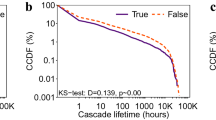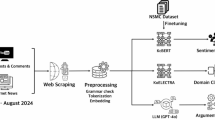Abstract
With the emergence and rapid proliferation of social media platforms and social networking sites, recent years have witnessed a surge of misinformation spreading in our daily life. Drawing on a large-scale dataset which covers more than 1.4M posts and 18M comments from an online social media platform, we investigate the propagation of two distinct narratives–(i) conspiracy information, whose claims are generally unsubstantiated and thus referred as misinformation to some extent, and (ii) scientific information, whose origins are generally readily identifiable and verifiable. We find that conspiracy cascades tend to propagate in a multigenerational branching process whereas science cascades are more likely to grow in a breadth-first manner. Specifically, conspiracy information triggers larger cascades, involves more users and generations, persists longer, and is more viral and bursty than science information. Content analysis reveals that conspiracy cascades contain more negative words and emotional words which convey anger, fear, disgust, surprise and trust. We also find that conspiracy cascades are much more concerned with political and controversial topics. After applying machine learning models, we achieve an AUC score of nearly 90% in discriminating conspiracy from science narratives using the constructed features.
We further investigate user’s role during the growth of cascades. In contrast with previous assumption that misinformation is primarily driven by a small set of users, we find that conspiracy cascades are more likely to be controlled by a broader set of users than science cascades, imposing new challenges on the management of misinformation. Although political affinity is thought to affect the consumption of misinformation, there is very little evidence that political orientation of the information source plays a role during the propagation of conspiracy information; Instead, we find that conspiracy information from media outlets with left or right orientation triggers smaller cascades and is less viral than information from online social media platforms (e.g., Twitter and Imgur) whose political orientations are unclear. Our study provides complementing evidence to current misinformation research and has practical policy implications to stem the propagation and mitigate the influence of misinformation online.









Similar content being viewed by others
Explore related subjects
Discover the latest articles and news from researchers in related subjects, suggested using machine learning.Notes
The raw data we used in this study are acquired from and publicly available at https://files.pushshift.io/reddit.
Kolmogorov-Smirnov test is abbreviated as K-S test hereafter.
References
Allcott, H., Gentzkow, M.: Social media and fake news in the 2016 election. J. Econ. Perspect. 31(2), 211–36 (2017)
Almaatouq, A., Shmueli, E., Nouh, M., Alabdulkareem, A., Singh, V.K., Alsaleh, M., Alarifi, A., Alfaris, A., et al: If it looks like a spammer and behaves like a spammer, it must be a spammer: analysis and detection of microblogging spam accounts. Int. J. Inf. Secur. 15(5), 475–491 (2016)
Anderson, A., Huttenlocher, D., Kleinberg, J., Leskovec, J., Tiwari, M.: Global diffusion via cascading invitations: Structure, growth, and homophily. In: Proceedings of the 24th International Conference on World Wide Web. ACM, pp. 66–76 (2015)
Aral, S., Eckles, D.: Protecting elections from social media manipulation. Science 365(6456), 858–861 (2019)
Bessi, A., Coletto, M., Davidescu, G.A., Scala, A., Caldarelli, G., Quattrociocchi, W.: Science vs conspiracy: Collective narratives in the age of misinformation. PloS ONE 10(2), e0118093 (2015)
Blei, D.M., Ng, A.Y., Jordan, M.I.: Latent dirichlet allocation. J. Mach. Learn. Res. 3(Jan), 993–1022 (2003)
Bovet, A., Makse, H.A.: Influence of fake news in Twitter during the 2016 US presidential election. Nat. Commun. 10(1), 7 (2019)
Brady, W.J., Wills, J.A., Jost, J.T., Tucker, J.A., Van Bavel, J.J.: Emotion shapes the diffusion of moralized content in social networks. Proc. Natl. Acad. Sci. 114(28), 7313–7318 (2017)
Callaway, D.S., Newman, M.E., Strogatz, S.H., Watts, D.J.: Network robustness and fragility: Percolation on random graphs. Phys. Rev. Lett. 85(25), 5468 (2000)
Cheng, J., Adamic, L., Dow, P.A., Kleinberg, J.M., Leskovec, J.: Can cascades be predicted?. In: Proceedings of the 23rd International Conference on World Wide Web. ACM, pp 925–936 (2014)
Cheng, J., Bernstein, M., Danescu-Niculescu-Mizil, C., Leskovec, J.: Anyone can become a troll: Causes of trolling behavior in online discussions. In: Proceedings of the 2017 ACM conference on Computer Supported Cooperative Work & Social Computing. ACM, pp 1217–1230 (2017)
Del Vicario, M., Bessi, A., Zollo, F., Petroni, F., Scala, A., Caldarelli, G., Stanley, H.E., Quattrociocchi, W.: The spreading of misinformation online. Proc. Natl. Acad. Sci. 113(3), 554–559 (2016)
Friggeri, A., Adamic, L., Eckles, D., Cheng, J.: Rumor cascades. In: Proceedings of the International AAAI Conference on Web and Social Media. Association for the Advancement of Artificial Intelligence, vol. 8, pp 101–110 (2014)
Goel, S., Anderson, A., Hofman, J., Watts, D.J.: The structural virality of online diffusion. Manag. Sci. 62(1), 180–196 (2015)
Goel, S., Watts, D.J., Goldstein, D.G.: The structure of online diffusion networks. In: Proceedings of the 13th ACM conference on Electronic Commerce. ACM, pp 623–638 (2012)
Goh, K.I., Barabási, A. L.: Burstiness and memory in complex systems. EPL Europhys. Lett. 81(4), 48002 (2008)
Gómez, V., Kappen, H.J., Kaltenbrunner, A.: Modeling the structure and evolution of discussion cascades. In: Proceedings of the 22nd ACM conference on Hypertext and Hypermedia, pp 181–190 (2011)
Gómez, V., Kappen, H.J., Litvak, N., Kaltenbrunner, A.: A likelihood-based framework for the analysis of discussion threads. World Wide Web 16 (5-6), 645–675 (2013)
Gottfried, J., Shearer, E.: Americans’ online news use is closing in on TV news use, Pew Res. Cent. https://www.pewresearch.org/fact-tank/2017/09/07/americans-online-news-use-vs-tv-news-use/ (2017)
Grinberg, N., Joseph, K., Friedland, L., Swire-Thompson, B., Lazer, D.: Fake news on Twitter during the 2016 US presidential election. Science 363(6425), 374–378 (2019)
Guan, L., Zhang, Y., Zhu, J.: Segmenting and characterizing adopters of e-books and paper books based on Amazon book reviews. In: Chinese National Conference on Social Media Processing. Springer, pp 85–97 (2016)
Guess, A., Nagler, J., Tucker, J.: Less than you think: Prevalence and predictors of fake news dissemination on Facebook. Sci. Adv. 5(1), eaau4586 (2019)
Guess, A., Nyhan, B., Reifler, J.: Selective exposure to misinformation: Evidence from the consumption of fake news during the 2016 US presidential campaign. Eur. Res. Counc. 9(3), 4 (2018)
Howell, L., et al.: Digital wildfires in a hyperconnected world. World Econ. Forum Rep. 3, 15–94 (2013)
Huang, Y.L., Starbird, K., Orand, M., Stanek, S.A., Pedersen, H.T.: Connected through crisis: Emotional proximity and the spread of misinformation online. In: Proceedings of the 18th ACM conference on Computer Supported Cooperative Work & Social Computing. ACM, pp 969–980 (2015)
Jones, N.M., Thompson, R.R., Schetter, C.D., Silver, R.C.: Distress and rumor exposure on social media during a campus lockdown. Proc. Natl. Acad. Sci. 114(44), 11,663–11,668 (2017)
Kumar, R., Mahdian, M., McGlohon, M.: Dynamics of conversations. In: Proceedings of the 16th ACM SIGKDD International Conference on Knowledge Discovery and Data Mining, pp 553–562 (2010)
Lazer, D.M., Baum, M.A., Benkler, Y., Berinsky, A.J., Greenhill, K.M., Menczer, F., Metzger, M.J., Nyhan, B., Pennycook, G., Rothschild, D., et al: The science of fake news. Science 359(6380), 1094–1096 (2018)
Liang, H.: Broadcast versus viral spreading: the structure of diffusion cascades and selective sharing on social media. J. Commun. 68(3), 525–546 (2018)
Medvedev, A.N., Delvenne, J.C., Lambiotte, R.: Modelling structure and predicting dynamics of discussion threads in online boards. J. Compl. Netw. 7(1), 67–82 (2019)
Mocanu, D., Rossi, L., Zhang, Q., Karsai, M., Quattrociocchi, W.: Collective attention in the age of (mis) information. Comput. Hum. Behav. 51, 1198–1204 (2015)
Mohammad, S.M., Turney, P.D.: Emotions evoked by common words and phrases: Using mechanical turk to create an emotion lexicon. In: Proceedings of the NAACL HLT 2010 workshop on computational approaches to analysis and generation of emotion in text. Association for Computational Linguistics, pp 26–34 (2010)
Mohammad, S.M., Turney, P.D.: Crowdsourcing a word–emotion association lexicon. Comput. Intell. 29(3), 436–465 (2013)
Newman, N., Fletcher, R., Kalogeropoulos, A., Levy, D., Nielsen, R.K: Reuters institute digital news report, pp 2017 (2017)
Park, P.S., Blumenstock, J.E., W., M.M.: The strength of long-range ties in population-scale social networks. Science 362(6421), 1410–1413 (2018)
Pei, S., Muchnik, L., Tang, S., Zheng, Z., Makse, H.A.: Exploring the complex pattern of information spreading in online blog communities. PloS ONE 10(5), e0126,894 (2015)
Pennycook, G., Rand, D.G.: Fighting misinformation on social media using crowdsourced judgments of news source quality. Proc. Natl. Acad. Sci. 116(7), 2521–2526 (2019)
Phan, X.H., Nguyen, C.T.: GibbsLDA++: A C/C++ implementation of Latent Dirichlet Allocation (LDA). Tech Rep (2007)
Qazvinian, V., Rosengren, E., Radev, D.R., Mei, Q.: Rumor has it: Identifying misinformation in microblogs. In: Proceedings of the conference on Empirical Methods in Natural Language Processing. Association for Computational Linguistics, pp 1589–1599 (2011)
Qiu, J., Li, Y., Tang, J., Lu, Z., Ye, H., Chen, B., Yang, Q., Hopcroft, J.E.: The lifecycle and cascade of Wechat social messaging groups. In: Proceedings of the 25th International Conference on World Wide Web. ACM, pp 311–320 (2016)
Romero, D.M., Uzzi, B., Kleinberg, J.: Social networks under stress. In: Proceedings of the 25th International Conference on World Wide Web. ACM, pp 9–20 (2016)
Ruths, D.: The misinformation machine. Science 363(6425), 348–348 (2019)
Shao, C., Ciampaglia, G.L., Varol, O., Yang, K.C., Flammini, A., Menczer, F.: The spread of low-credibility content by social bots. Nat. Commun. 9(1), 4787 (2018)
Shu, K., Sliva, A., Wang, S., Tang, J., Liu, H.: Fake news detection on social media: A data mining perspective. ACM SIGKDD Explor. Newsl. 19(1), 22–36 (2017)
Singer, P., Lemmerich, F., West, R., Zia, L., Wulczyn, E., Strohmaier, M., Leskovec, J.: Why we read Wikipedia. In: Proceedings of the 26th International Conference on World Wide Web. ACM, pp 1591–1600 (2017)
Starbird, K., Maddock, J., Orand, M., Achterman, P., Mason, R.M.: Rumors, falseflags, and digital vigilantes: Misinformation on Twitter after the 2013 Boston Marathonbombing. In: iConference 2014 Proceedings, pp. 654–662. iSchools (2014)
Stella, M., Ferrara, E., De Domenico, M.: Bots increase exposure to negative and inflammatory content in online social systems. Proc. Natl. Acad. Sci. 115(49), 12,435–12,440 (2018)
Vosoughi, S., Roy, D., Aral, S.: The spread of true and false news online. Science 359(6380), 1146–1151 (2018)
Way, S.F., Larremore, D.B., Clauset, A.: Gender, productivity, and prestige in computer science faculty hiring networks. In: Proceedings of the 25th International Conference on World Wide Web. ACM, pp. 1169–1179 (2016)
Zhang, Y., Guan, L., Chen, H., Zhu, J.: Using text mining to measure diffusion of innovation. In: The 67th Annual Conference of the International Communication Association: Interventions: Communication Research and Practice (2017)
Acknowledgements
This work was supported by the National Natural Science Foundation of China (Grant Nos. 61773255 and 61873167), Hong Kong RGC (GRF 11505119) and City University of Hong Kong (CCR 9360120 and HKIDS 9360163). The authors would like to thank Tai-Quan “Winson” Peng for critical reading of the early draft.
Author information
Authors and Affiliations
Corresponding authors
Additional information
Publisher’s note
Springer Nature remains neutral with regard to jurisdictional claims in published maps and institutional affiliations.
Appendix
Appendix
Rights and permissions
About this article
Cite this article
Zhang, Y., Wang, L., Zhu, J.J.H. et al. Conspiracy vs science: A large-scale analysis of online discussion cascades. World Wide Web 24, 585–606 (2021). https://doi.org/10.1007/s11280-021-00862-x
Received:
Revised:
Accepted:
Published:
Issue Date:
DOI: https://doi.org/10.1007/s11280-021-00862-x




